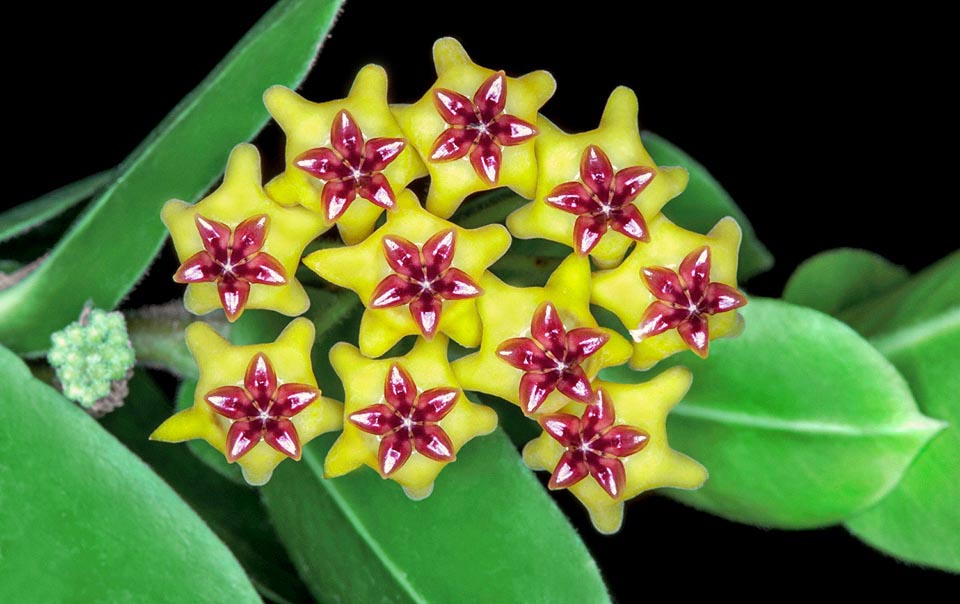Family : Apocynaceae

Text © Pietro Puccio

English translation by Mario Beltramini
The species is native to Borneo, Java and Philippines (Luzon, Mindoro and Palawan) where it usually grows on calcareous rocks, from the sea level up to about 1600 m of altitude.
The genus is dedicated to Thomas Hoy (ca. 1750-1822), botanist and curator of the gardens of the duke of Northumberland; the species is dedicated to the English collector and gatherer Hugh Cuming (1791-1865) who collected the samples in the Philippines.
Common names: bush hoya, Cuming’s hoya (English).
The Hoya cumingiana Decne. (1844) is an evergreen sarmentose species, terrestrial or lithophyte, ramified at the base with thin green herbaceous stems, up to about 1,5 m long, basically ascending, with close nodes. The leaves, subsessile, are opposite, decussate, simple, ovate-elliptic with cordate base and acute or obtuse apex, entire margin and prominent central vein below, thin, flat, coriaceous, of pale green colour anf glossy above, 3-5 cm long and 1,5-3 cm broad.
Drooping axillar umbel inflorescences arranged in the terminal part of the branches, of about 6 cm of diameter, bearing up to 20 slightly perfumed flowers, of about 1,2 cm of diameter, with corolla having a waxy appearance with 5 triangular lobes with acute apex, retroflexed, of greenish yellow colour and corona with fleshy segments, glossy, of reddish brown colour; the flowers last about one week and the peduncles are not remontant, but fall after blooming.

The Hoya cumingiana is sarmentose, terrestrial or lithophyte, ramified at the base reaching 150 cm of height. Even 20 umbellar flowers of 1,2 cm of diameter © G. Mazza
It easily propagates by seed, placed superficially on draining loam maintained humid at the temperature of 24-26 °C, by cutting and air layering.
Species of easy cultivation with unusual look and particular needs within the genus, cultivable in open air only in the tropical and subtropical climate zones, standing among the most demanding about the temperature. It requires a very luminous position, also some hours of direct sun in the morning, and draining and aerated substrata rich of organic substance with addition of fragments of rock or calcareous gravel. It well adapts to the cultivation in pot, left free or guided on supports, to be sheltered, in the less favourable climates, in a protected ambient at the maximum possible luminosity and with lowest winter temperatures over the 16 °C. Regular and abundant waterings in summer, but allowing the substratum to dry up before giving water again, and frequent nebulizations with water at ambient temperature, non calcareous in order to avoid unaesthetic spots on the leaves, spaced in winter to maintain the loam just humid. For the fertilizations, in spring-summer, can be utilized hydrosoluble balanced products, with microelements at 1/3 of the suggested dosage. Periodical prunings, after blooming, help in keeping compact the posture of the plant.
Synonyms: Hoya densifolia Turcz. (1848).
→ To appreciate the biodiversity within the APOCYNACEAE family please click here.
